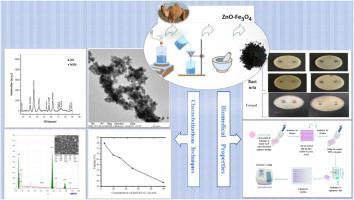Eco-friendly synthesis of magnetic ZnO/Fe3O4 nanocomposites: Structural, morphological, antimicrobial, and anticancer evaluation
IF 6.8
3区 材料科学
Q1 MATERIALS SCIENCE, MULTIDISCIPLINARY
Journal of Science: Advanced Materials and Devices
Pub Date : 2025-06-14
DOI:10.1016/j.jsamd.2025.100921
引用次数: 0
Abstract
The synthesis of nanomaterials has traditionally relied on physical and chemical methods, which, while initially effective, are often expensive and environmentally detrimental. In contrast, biological approaches utilizing natural agents such as plant extracts, enzymes, and microorganisms offer more sustainable and eco-friendly alternatives. In this study, bio-synthesized ZnO/Fe3O4 nanocomposites (NCs) were prepared via a chemical precipitation method, using camel urine as a natural stabilizing and capping agent. The synthesized NCs were comprehensively characterized using SEM, EDX, TEM, XRD, UV–Vis spectroscopy, FTIR, and TGA. Transmission electron microscopy revealed an average particle size of 7.41 nm, while XRD analysis confirmed the polycrystalline nature of the ZnO/Fe3O4 NCs. UV–Vis analysis indicated an energy band gap of 2.21 eV. FTIR spectra identified functional groups associated with ZnO/Fe3O4, and TGA demonstrated thermal stability up to 940 °C. The nanocomposites exhibited significant anticancer and antibacterial activities in a concentration-dependent manner. MTT assays against HCT116 colorectal cancer cells showed a reduction in cell viability from approximately 80 % at low concentrations to about 43 % at 100 μg/mL, indicating strong dose-dependent cytotoxicity. Antibacterial tests revealed higher efficacy against Gram-negative bacteria (E. coli, Pseudomonas sp.) than Gram-positive strains (S. aureus), with no observable activity against MRSA. Notably, at a concentration of 15 mg, inhibition zones reached 0.9 mm for Pseudomonas sp. and 1.4 mm for E. coli, whereas significantly smaller zones were observed at lower concentrations. These findings highlight the potential of ZnO/Fe3O4 NCs for biomedical applications, particularly as antibacterial coatings or anticancer agents. To the best of our knowledge, this is the first report on the synthesis of ZnO/Fe3O4 NCs using camel urine and their evaluation against colorectal cancer cells, representing a novel and sustainable approach in nanomedicine.

磁性ZnO/Fe3O4纳米复合材料的生态友好合成:结构、形态、抗菌和抗癌评价
纳米材料的合成传统上依赖于物理和化学方法,这些方法虽然最初有效,但往往昂贵且对环境有害。相比之下,利用植物提取物、酶和微生物等天然试剂的生物方法提供了更可持续和环保的替代品。本研究采用化学沉淀法,以骆驼尿为天然稳定和封盖剂,制备了生物合成的ZnO/Fe3O4纳米复合材料(NCs)。采用SEM、EDX、TEM、XRD、UV-Vis、FTIR、TGA等手段对合成的纳米碳化合物进行了表征。透射电子显微镜显示ZnO/Fe3O4纳米管的平均粒径为7.41 nm, XRD分析证实了ZnO/Fe3O4纳米管的多晶性质。UV-Vis分析表明该材料的能带隙为2.21 eV。FTIR光谱鉴定出与ZnO/Fe3O4相关的官能团,TGA表明ZnO/Fe3O4的热稳定性高达940°C。纳米复合材料具有明显的抗肿瘤和抗菌活性,且呈浓度依赖性。对HCT116结肠直肠癌细胞的MTT实验显示,细胞活力从低浓度时的约80%降低到100 μg/mL时的约43%,表明具有强剂量依赖性的细胞毒性。抗菌试验显示,对革兰氏阴性菌(大肠杆菌、假单胞菌)的抑菌效果高于革兰氏阳性菌(金黄色葡萄球菌),而对MRSA的抑菌活性未观察到。值得注意的是,在浓度为15 mg时,对假单胞菌的抑制区达到0.9 mm,对大肠杆菌的抑制区达到1.4 mm,而在较低浓度下观察到的抑制区要小得多。这些发现突出了ZnO/Fe3O4纳米材料在生物医学上的应用潜力,特别是作为抗菌涂层或抗癌剂。据我们所知,这是第一篇利用骆驼尿合成氧化锌/Fe3O4纳米细胞及其对结直肠癌细胞的评价的报道,代表了纳米医学的一种新的和可持续的方法。
本文章由计算机程序翻译,如有差异,请以英文原文为准。
求助全文
约1分钟内获得全文
求助全文
来源期刊

Journal of Science: Advanced Materials and Devices
Materials Science-Electronic, Optical and Magnetic Materials
CiteScore
11.90
自引率
2.50%
发文量
88
审稿时长
47 days
期刊介绍:
In 1985, the Journal of Science was founded as a platform for publishing national and international research papers across various disciplines, including natural sciences, technology, social sciences, and humanities. Over the years, the journal has experienced remarkable growth in terms of quality, size, and scope. Today, it encompasses a diverse range of publications dedicated to academic research.
Considering the rapid expansion of materials science, we are pleased to introduce the Journal of Science: Advanced Materials and Devices. This new addition to our journal series offers researchers an exciting opportunity to publish their work on all aspects of materials science and technology within the esteemed Journal of Science.
With this development, we aim to revolutionize the way research in materials science is expressed and organized, further strengthening our commitment to promoting outstanding research across various scientific and technological fields.
 求助内容:
求助内容: 应助结果提醒方式:
应助结果提醒方式:


